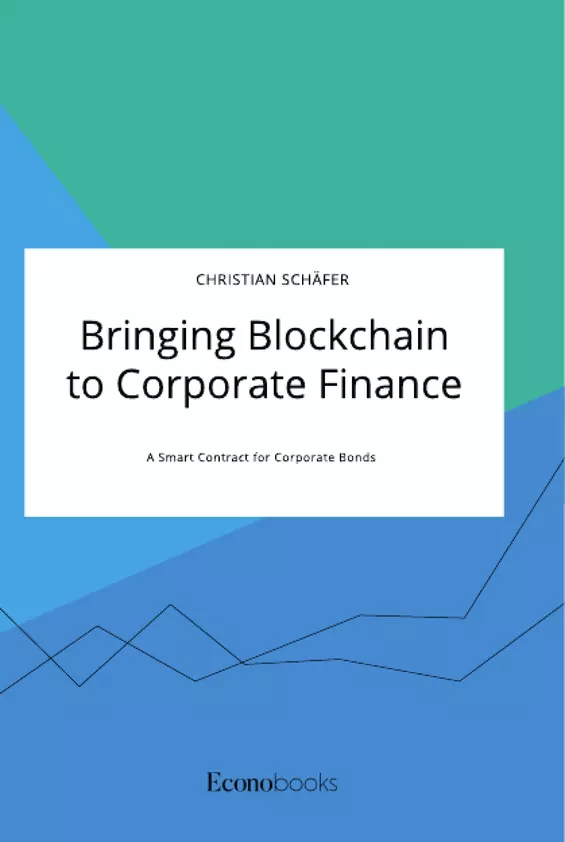Originally intended to be an innovative electronic payment system, the new technology Bitcoin could have a disruptive impact on other industries as well. Blockchain enthusiasts, private companies, government and academic institutions are currently trying to stake out and unlock the full spectrum of the technology's potential.
Capital market transactions are among these use cases as many players are involved in these transactions, resulting in high costs and long transaction times. By integrating blockchain technology into the settlement of security transactions, the cost and complexity of the processes might be reduced. As Christian Schäfer explains, the crucial instrument for the realization of these potentials are smart contracts, enabled by the Ethereum Blockchain.
In his books, Schäfer examines the technical feasibility of a smart contract that enables the issuing and trading of corporate bonds without intermediaries. The key features for the smart contract have been derived from the payment mechanisms of a bond and the standard for token contracts established within the Ethereum developer community. The requirements for the smart contract could be implemented successfully, as confirmed by the documentation of two simulations.
In this book:
- Internet of Things;
- solidity;
- token;
- ERC20 standard;
- corporate bonds
Inhaltsverzeichnis (Table of Contents)
- Abstract
- Tabellenverzeichnis (Table of Contents)
- 1 Introduction
- 2 Smart Contracts
- 2.1 Solidity
- 2.2 Tokens
- 2.3 ERC20 standard
- 3 Corporate Bonds
- 4 Requirements for the Smart Contract
- 5 Remix
- 6 The Bond Token Smart Contract
- 7 Simulations
- 7.1 Simulation one
- 7.2 Simulation two
- 8 Evaluation of the smart contract
- References
- Internet references
- Appendix
Zielsetzung und Themenschwerpunkte (Objectives and Key Themes)
This master thesis aims to investigate the technical feasibility of utilizing blockchain technology in a corporate finance setting. Specifically, it focuses on developing a smart contract for issuing and trading corporate bonds without the involvement of intermediaries. The smart contract draws upon payment mechanisms typical for bonds and the established ERC20 standard for token contracts within the Ethereum ecosystem. The core features are implemented using Solidity, a JavaScript and C-inspired programming language specifically designed for Ethereum applications. The research employs the Remix development environment for coding and testing the contract, culminating in two simulations to validate the successful implementation of the defined requirements.
- Technical feasibility of blockchain applications in corporate finance
- Development of a smart contract for bond issuance and trading
- Application of Solidity programming language
- Utilization of the ERC20 standard for token contracts
- Testing and validation through simulations
Zusammenfassung der Kapitel (Chapter Summaries)
- Chapter 1: Introduction: This chapter provides an overview of the topic, outlining the research objectives and context. It emphasizes the potential of blockchain technology to revolutionize corporate finance, specifically highlighting the potential of smart contracts to streamline bond issuance and trading processes.
- Chapter 2: Smart Contracts: This chapter delves into the concept of smart contracts and their relevance in the blockchain environment. It introduces Solidity, the programming language employed in this thesis, and discusses the ERC20 standard, a widely adopted framework for token contracts. This section provides a foundational understanding of the key technologies underpinning the research.
- Chapter 3: Corporate Bonds: This chapter explores the characteristics of corporate bonds, focusing on the payment mechanisms and legal framework governing their issuance and trading. This chapter serves to provide a technical understanding of the financial instrument under consideration.
- Chapter 4: Requirements for the Smart Contract: This chapter outlines the specific requirements for the smart contract designed for bond issuance and trading. It details the functionality and features that the contract must possess to effectively facilitate these processes.
- Chapter 5: Remix: This chapter introduces the Remix development environment, the platform utilized for coding and testing the smart contract. It explains the tools and functionalities available in Remix, providing a context for the practical development process.
- Chapter 6: The Bond Token Smart Contract: This chapter presents the details of the developed smart contract, outlining its architecture, code structure, and specific functions. It provides a comprehensive analysis of the contract's functionality, demonstrating its ability to execute bond issuance, trading, and settlement.
- Chapter 7: Simulations: This chapter describes the two simulations conducted to validate the implementation of the smart contract. Each simulation focuses on different aspects of the bond lifecycle, demonstrating the contract's effectiveness in handling diverse scenarios.
Schlüsselwörter (Keywords)
The central keywords and focus areas of this thesis encompass blockchain technology, smart contracts, Solidity programming language, ERC20 standard, corporate bonds, bond issuance and trading, and decentralized finance. The research investigates the practical implementation of these concepts, aiming to demonstrate the potential of blockchain technology to revolutionize traditional financial processes.
- Citar trabajo
- Christian Schäfer (Autor), 2020, Bringing Blockchain to Corporate Finance. A Smart Contract for Corporate Bonds, Múnich, GRIN Verlag, https://www.grin.com/document/511342



